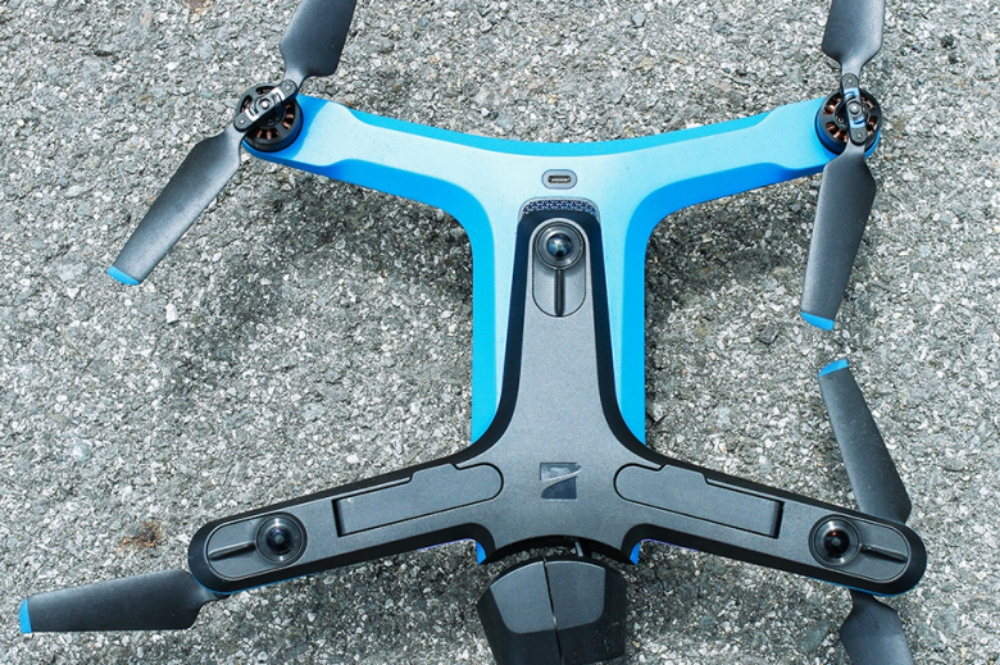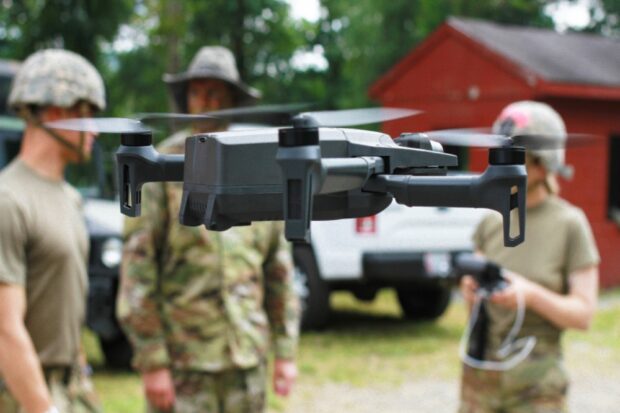Improving data collection and communication methods on the battlefield is an ever-evolving process at the West Point U.S. Military Academy. Because of this, professors in the Department of Electrical Engineering and Computer Science lent their robotics expertise to cadets to expand their training in battlefield tactics through the use of unmanned aerial vehicles (drones) during Cadet Leadership Development Training from July 26-28.
Faculty members at EECS ordered the parts to build the drones and programmed coded algorithms that would allow cadets to control and maneuver the technology in various ways.
Organized at the forest grounds of Camp Shea, senior and junior cadets engaged in notional yet dynamic combat scenarios that developed their techniques and procedures to react to small UAVs during a firefight. Cadets also learned how to leverage the drone’s intelligence gathering, surveillance and reconnaissance (ISR) capabilities as they explored how to execute lethal engagements to discriminate and distinguish between notional friendlies and enemy combatants.
With that, all of the training conducted during CLDT was influenced by how researchers at EECS created the drones.
They installed the motors, applied speed controllers, fitted propellers and wiring, installed the power distribution and management and applied the flight controller on the battery compartment, essentially building everything from scratch, Col. Christopher Korpela, the director of the Robotics Research Center, said.
“There’s benefits to applying the pieces yourself and adding additional features that can assist cadets out in the field,ˮ Korpela added. “If one wanted to add certain payloads, cameras and we want to add an acoustic sensor, we want to add a lidar, we want to add a high end inertial navigation system for really accurate information on your location — we can customize it.ˮ
Cadets were issued several distinct drone models, each with its own specific features. The Skydio 2 drone was among the cheaper models, which can fly for 15-20 minutes and gives you a standard birdʼs eye view of whatʼs happening on the ground.

The Skydio 2 drone helps to gather intel on the enemy relative to the platoonʼs position and is used in training by cadets during Cadet Leadership Development
The Skydio X2D is one of the more advanced drones fitted with unique features, including obstacle avoidance, which allows the drone to detect and avoid obstacles in its path. The X2D also has thermal imaging cameras that can detect heat signatures, which enabled cadets, during training, to detect enemies hiding under thick foliage. Finally, the Parrot Anafi drone holds a slightly longer battery life and thermal imaging features.
“Cadets typically use the drone for several things, the first thing is to check their positions to see if they’re exposed to the enemy because we know that the opponent also has the same technological capabilities, so platoon leaders want to make sure their platoons are strategically hidden,ˮ Dr. Michael Novitzky, an assistant professor in the EECS Department, said. “Second is cadets are always looking for the enemy location, their size and their methods of maneuverability. The third use, which has the most significant impact, is calling indirect fire.ˮ
Class of 2023 Cadet Christian Litton experienced this first hand as he led a platoon to victory during training. However, his path to victory came with failures that helped him understand which direction to take in operating the drones and using his map in the most effective way possible.
“I was a platoon leader for the very first lane for CLDT in my platoon. I didn’t coordinate that lane very well because it was the first time I did this,ˮ Litton said. “…One of the main mistakes I made was I did not get eyes on the enemy before I maneuvered my platoon. One of the biggest advantages that ISR drone platforms provide is I, as the commander in combat training, can see the chess board and observe where the pieces are so I can maneuver my pieces to the safest and most strategically secure battle positions.ˮ
With the drone’s bird’s eye view, Litton obtained information on the enemyʼs location. Soon after, he would use the enemy disposition to maneuver his gun teams and effectively call for indirect fire.
“This method of combat is something that weʼre seeing a lot of in eastern Europe right now — coordinating firefights between drones and between infantry on the ground or even drones deploying explosives from above,ˮ Litton said. “We were able to confirm that the enemy was moving to Building 5, in the notional village, through the combination of map reading and information we gathered from the drone.ˮ
The drone pilot moved to various locations in the forest based on Littonʼs calculated intuition. Then, he called for fire onto Building 5 and eliminated an entire enemy squad, which was approximately an eighth of the enemy’s forces.
“He made sure his communication equipment was intact. He kept a topographic map on him to identify and monitor where his people were and then narrowed that battlefield down,ˮ Novitzky said. “When he got a new report he updated his map. I was like, ‘man, battle tracking? This guy is on another level.’ The reason I bring him up is that during the exercise when he was talking to the drone operator, you can hear he was actively looking for new information to notate and apply it to the success of his mission.ˮ
The training concluded and Novitzky needed feedback on the effectiveness of the drones. An After Action Review was held. That’s when he asked Litton, “how was the drone useful? Was the drone not useful at times? What would you improve?ˮ
Litton said he and his team were able to get a birdʼs eye view of the landscape and get confirmation on sightings on the size of the enemy. So, whenever he found that the enemy was down in numbers, that would help him figure out, on the map, what elements he would look for to make an educated decision.
“After the AAR, he came back to me with a request, he goes, ‘I want it to be faster.’ So, we were talking about that and I was like, ‘well there are some limitations to speeding it up, but what if we put two drones up? Would that be better?ʼ He said it would be,ˮ Novitzky said.
Novitzky added how humbling the experience was working with cadets and watching them take the department’s research off the ground.
“I’m living my research dream right now,ˮ Novitzky said. “I was allowed to do some research where people were somewhat stressed in using my tech. I learned some basic lessons like communication equipment is super important. If the tech you develop fails a cadet, he or she is going to stop using it. Being able to come to West Point and incorporate my research to summer training like this is just taking it to a whole other level.ˮ
Top Photo: Dr. Michael Novitzky, an assistant professor in the Department of Electrical Engineering and Computer Science, instructs cadets on how to pilot the Parrot Anafi drone during Cadet Leadership Development Training from July 26-28 at the U.S. Military Academy. Photo Credits: Jorge Garcia/PV
Source: Press Release

